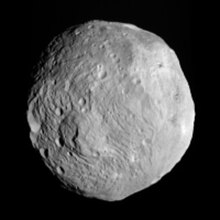
Back 4 Vesta Afrikaans (4) Vesta ALS 4 فيستا Arabic 4 فيستا (كويكب) ARZ 4 Vesta AST (4) Vesta Azerbaijani (4) Веста Byelorussian Вэста (астэроід) BE-X-OLD 4 Веста Bulgarian (4) Vesta Breton
 4 Vesta seen by Dawn spacecraft July 9, 2011 | |
| Discovery | |
|---|---|
| Discovered by | Heinrich Wilhelm Olbers |
| Discovery date | March 29, 1807 |
| Designations | |
| none | |
| Main belt (Vesta family) | |
| Orbital characteristics | |
| Epoch November 26, 2005 (JD 2453700.5) | |
| Aphelion | 384.72 Gm (2.572 AU) |
| Perihelion | 321.82 Gm (2.151 AU) |
| 353.268 G m (2.361 AU) | |
| Eccentricity | 0.08902 |
| 1325.46 d (3.63 a) | |
Average orbital speed | 19.34 km/s |
| 205.652° | |
| Inclination | 7.133° |
| 103.926° | |
| 150.297° | |
| Physical characteristics | |
| Dimensions | 578×560×458 km[1] |
| Mass | 2.7×1020 kg[2] |
Mean density | 3.4 g/cm³ |
| 0.22 m/s² | |
| 0.35 km/s | |
| 0.2226 d[3] | |
| Albedo | 0.423 (geometric)[4] |
| Temperature | min: 85 K (-188° C) max: 255 K (-18 °C)[5] |
Spectral type | V-type asteroid[6] |
| 5.1[7] to 8.48 | |
| 3.20[4] | |
| 0.64" to 0.20" | |
4 Vesta (IPA: [ˈvɛstə]) is the second most massive asteroid in the solar system, with an average diameter of about 530 km (around 330 miles) and an estimated mass of 9% of the mass of the entire asteroid belt. Its size and unusually bright surface makes Vesta the brightest asteroid, and the only one ever visible to the naked eye from Earth. Vesta's astronomical symbol is ![]() .
.
- ↑ P. C. Thomas et al. Impact excavation on asteroid 4 Vesta: Hubble Space Telescope results, Science, Vol. 277, pp. 1492 (1997).
- ↑ Pitjeva, E. V. (2004). "Estimations of masses of the largest asteroids and the main asteroid belt from ranging to planets, Mars orbiters and landers". 35th COSPAR Scientific Assembly. Held 18 - July 25, 2004, in Paris, France. Vol. 35. p. 2014. Bibcode:2004cosp...35.2014P.
- ↑ Harris, A. W. (2006). "Asteroid Lightcurve Derived Data. EAR-A-5-DDR-DERIVED-LIGHTCURVE-V8.0". Warner, B.D.; Pravec, P.; Eds. NASA Planetary Data System. Retrieved March 15, 2007.
- ↑ 4.0 4.1 Tedesco, E.F. (2004). "IRAS Minor Planet Survey. IRAS-A-FPA-3-RDR-IMPS-V6.0". Noah, P.V.; Noah, M.; Price, S.D. NASA Planetary Data System. Retrieved March 15, 2007.
- ↑ T. G. Mueller and L. Metcalfe ISO and Asteroids[permanent dead link], ESA bulletin Vol. 108, p. 38 (2001).
- ↑ Neese, C., ed. (2005). "Asteroid Taxonomy.EAR-A-5-DDR-TAXONOMY-V5.0". NASA Planetary Data System. Retrieved March 15, 2007.
- ↑ Donald H. Menzel and Jay M. Pasachoff (1983). A Field Guide to the Stars and Planets (2nd ed.). Boston, MA: Houghton Mifflin. p. 391. ISBN 0-395-34835-8.